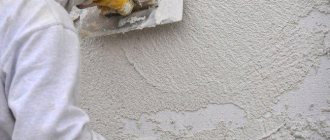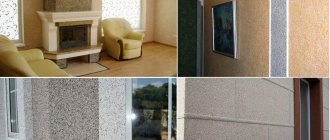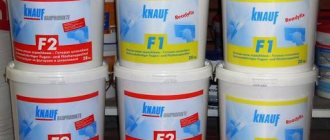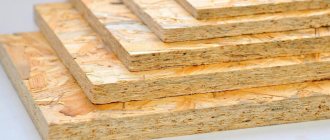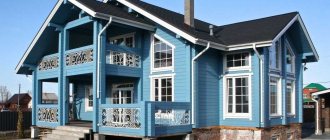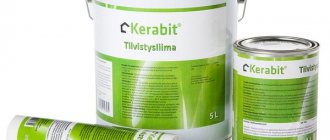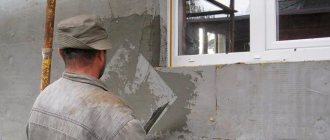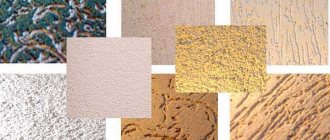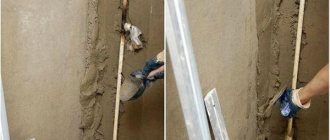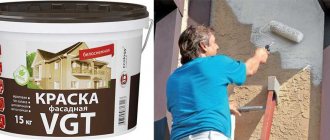Finishing materials, the main ingredients of which include liquid glass, have been used in construction work for quite a long time. Thanks to the specific composition and properties of the main components, it is possible to protect the surface from moisture and at the same time create a fairly dense and aesthetically attractive coating.
But, before you start using silicate plasters for interior or exterior decoration, you should evaluate the main characteristics of this material and application methods.
Composition of silicate plaster
Before understanding the physical and chemical features of this coating, you should consider its composition. Since it is he who provides certain parameters.
Silicate plaster includes the following main components:
- Liquid glass.
- Sand as a filler.
- Some mixtures contain plasticizers, mineral-based fillers, functional additives and coloring pigments.
Silicate plasters are sold ready-made
What it is
Glass, which is called liquid glass, is a material known since the beginning of the 19th century. It was first obtained by the German chemist Fuchs when he tried to influence silicic acid with alkalis. This material is called glass because of its external similarity. When hardened, the mass becomes transparent and glassy. The main components of liquid silicates are water-soluble potassium and sodium silicates. Modern liquid glass is produced using various technologies.
Therefore, there are two main groups:
- Sodium is a highly adhesive substance that adheres to minerals, is resistant to temperature changes, and is not afraid of exposure to atmospheric factors.
- Potassium - has similar properties, except that it does not shine.
The use of liquid glass as a base for plaster mortars gave rise to a new type of plasters - silicate ones.
Specifications
Thanks to two main ingredients, as well as additional additives, the silicate composition for plaster has the following characteristics:
- High level of density of the formed layer.
- Wide operating temperature range. The surface retains its basic characteristics in the range from -50° to +70°C.
- The surface can withstand up to 100 freeze-thaw cycles.
- When the composition thickens, it is quite easy to bring it to the desired concentration by diluting it with water.
- The service life of most mixtures is on average 25 years. Although, in some varieties it is increased to 50 years.
- The surface is resistant to dirt, due to which it retains its attractive appearance for a long time.
These are the main technical characteristics, which may differ slightly for different types of plasters.
Composition and advantages of use
One of the most important characteristics of any coating will be the substances from which the mixture is prepared. In silicate mixtures, the binder will be the well-known combination of calcium and potassium silicates, which has the “popular” name “liquid glass”. In addition to the binder, among the components you can find various mineral fillers, modifiers that improve the properties of plasters and dyes. It also contains some water and impurities that provide resistance to mold and mildew. The undeniable advantages of this material include several factors:
- After finishing, the surface turns out smooth and beautiful, and for the most part, preliminary leveling is not required at all.
- The coating will “breathe”, which will ensure normal air exchange in any type of room.
- Despite the excellent vapor permeability, the coating is moisture resistant and is not afraid of water. Can be used to decorate the walls of bathrooms, kitchens and other similar parts of the house.
- For many, an important point will be the high fire safety of the material.
- The composition is easily applied to a surface pre-treated with a special primer, as it has excellent adhesion even to porous substrates.
- There is no need to dilute the ready-made solution sold with anything, and there is no need to do anything other than thoroughly mixing the existing composition.
- You can purchase a white composition, which is either tinted to the desired shade immediately, or painted after application to the plane of the walls.
- Such mixtures are supplied in plastic buckets of different volumes, which will make it possible to buy exactly as much plaster as you need.
- When choosing a composition, take into account the filling component included in it - different fillers give different effects and you can create planes with different textures.
- There is a variety with the addition of silicone resins, which provide the mixtures with greater elasticity and adhesion to substrates compared to standard varieties.
- When the coating dries, it will not crack, just like after the surface has completely dried.
- The coating will not attract dust, as it is neutral electrostatically.
In general, silicate decorative plaster will be a good choice both for exterior decoration of your home and for indoor work.
Types of silicate plasters
Silicate plasters are divided according to their area of application, that is, they are:
- for outdoor work;
- for interior work.
Silicate plaster is most often used for facade work, as it is resistant to external factors. When using indoors, do not forget about ventilation.[/tds_council]
There is also silicate-silicone plaster. It has the same properties, but is more elastic.
Kinds
The base of silicate plasters of various types remains practically unchanged, but due to the use of fillers, the applied material can acquire a different texture. Most often, small pebbles are used for this purpose, thanks to which the well-known “Bark Beetle” coating is obtained. Coarse sand is also used in this capacity.
A variation of this type is a silicate-silicone mixture. Polymers are added to the plaster, giving the finished surface elasticity. Thanks to this quality, it is possible to effectively use the composition even on curved surfaces.
Silicate plaster for facades can also be effectively used for interior work. This material is especially suitable for treating the walls of basements and basements. In the bathroom and kitchen, a silicate layer will be a good barrier to moisture penetration to the wall.
Silicate decorative plaster
From the point of view of the specifics of the outer layer, which is formed after applying the mixture, plasters are divided into the following types according to decorative parameters:
- Bark beetle
- "Fur coat" effect.
- Lamb type.
- Pebble variety.
Plastering technology
Base requirements
Before you start plastering, you need to make sure that the load-bearing base:
- Durable;
- Rivne;
- Cleaned from dust, dirt, anti-adhesive agents, mold, fungi, etc.;
- Has no chips or cracks;
If the surface does not meet all these requirements, then it is necessary to carry out preparatory work - treat the walls with an antibacterial agent, perform rough plaster or repair cracks using a putty-leveling solution.
To complete the preparation, the walls must be coated with a special primer for silicate plaster.
Applying plaster to the wall
Applying plaster
The instructions for finishing walls with decorative plaster are quite simple and consist of two stages:
- The composition is applied to the walls using a wide spatula or stainless steel float. The thickness of the layer should be equal to the thickness of the filler grain. The solution can be collected using a narrow spatula.
- After pulling off the excess solution, the surface must be rubbed using a plastic trowel, using vertical, horizontal or circular movements, which depends on the desired texture. For these purposes, you need to use a plastic grater.
Note! When working with plaster, it is necessary to avoid contact with skin and be sure to protect your eyes. If the composition gets into your eyes, rinse them with plenty of water and seek help from a doctor. If the coating gets on your skin, the contact area must be washed with water.
In the photo - rubbing plaster with a plastic float
In order for plastering to be of high quality, it is necessary to take into account a number of nuances:
- During work, the plaster should not be wetted with water.
- Plastering work on one wall must be carried out in a continuous manner, i.e. Apply the composition “wet on wet”, this will avoid visible differences in the color of the coating.
- If the wall cannot be finished in a continuous manner, then it must be divided into several fragments with clear, straight boundaries, which can be done using plaster adhesive tape.
- During the plastering process, it is not recommended to completely empty the bucket with the composition. It is necessary to constantly add mass when half the bucket is used up. In this case, the fresh plaster must be thoroughly mixed with the old mass. This will also help even out the color of the coating.
- Plastering should not be carried out during rainfall, strong sun or windy weather. If it is impossible to postpone the work, then special protective compounds should be used that limit the influence of atmospheric factors.
- The freshly plastered surface must be protected from rain, too rapid drying or frost. The average drying time for the coating is 12-48 hours. However, high humidity or low temperature can significantly increase this time.
Advice! When working with colored plaster, you need to pay attention to using the same series of coating on one wall.
Application area
Silicate-based finishing mixtures can withstand different temperature conditions. Therefore, it is used everywhere:
- For facade work. In this case, it is possible to achieve not only an attractive appearance, but also maintain the integrity of the surface throughout its long service life.
- For interior decoration. It can effectively protect the surface from moisture.
Lamb + bark beetle on the facade
Facade plaster for exterior use
Thanks to modern brick, many buildings can be given five stars for their appearance. Wooden houses have always been and will be beautiful. However, in addition to these building materials, there are many others. They are no less practical and can be more attractive in cost. They all have one thing in common - they all (or almost all) require additional finishing, such as whitewashing or painting. However, plastering is considered its most popular and effective type.
The reason here is not only the desire to increase aesthetic appeal, not only to “play with color,” not only to improve the performance qualities of the wall and foundation materials, but also to protect the house, its walls and foundation.
Let's try to analyze facade plaster, its properties, main characteristics and determine the optimal fit for finishing a house with your own hands.
Facade plaster - combination of types
Base requirements
Before applying the solution to the surface, you need to not only wipe it down and level it, but also make sure that the wall material is suitable for silicate plaster. This is an important condition that will ensure the desired level of adhesion.
All this not only worsens the aesthetic characteristics, but will also require fairly quick repair work and a complete remodel.
On what walls can it be used?
Wall finishing with silicate plaster is permissible if this surface is made of:
- Aerated concrete or foam concrete blocks.
- Concrete and in the form of gas silicate blocks.
- Shell rock.
- Chipboard.
- Any material that is covered with cement or gypsum plaster.
- Plasterboard sheets.
- In the case when the surface is insulated with polystyrene foam or mineral wool sheets.
Facade work using silicate plasters cannot be carried out if:
- rain;
- direct sunlight;
- strong wind.
On what walls can it be used?
The high vapor permeability of the material makes it the most preferred finishing agent for porous or cellular concrete - aerated concrete, gas silicate blocks, etc.
Silicate plaster will not create obstacles to the removal of water vapor from the wall material, while at the same time reliably protecting it from external rain or atmospheric moisture.
In addition, silicate plaster is excellent for forming an external finishing layer on external insulation , in particular on slab mineral wool.
The rigidity and strength of the material are sufficient to protect the insulation from mechanical damage, and water resistance will not allow it to get wet.
NOTE!
To fix the composition on mineral wool, you will need a reinforcing fiberglass mesh , and on polystyrene foam - a silicate primer (preliminary application).
At the same time, there are no contraindications for using silicate plaster on other materials, but you will first need to apply a layer of primer to ensure stronger adhesion of the materials and prevent peeling.
Technology of applying silicate plaster
Wall finishing must be done correctly so that the silicate plaster surface lasts as long as possible and retains its visual appeal.
Surface preparation
- Initially, remove the old coating. This could be stripping the paint layer or removing wallpaper. It is important to remove everything so that the wall remains smooth.
- The surface is cleaned of dust.
- A silicate primer must be applied to the surface. It allows you to ensure the desired level of adhesion.
Tool
To work with silicate plaster, you will need to prepare the following types of tools:
- Several trowels of different sizes.
- Spatulas, which will also have different shapes and sizes, for ease of use.
- Graters made of plastic.
- Rollers or brushes with which the composition will be applied or a special textured pattern will be made on it. In this case, you can use other devices that match the composition.
- Additionally, you should prepare masking tape, which will help keep areas clean where the plaster should not get in.
- They also take containers where the compounds can be diluted.
- Plumb lines will ensure even application.
- Rags are needed for cleaning.
Application
The composition must be kneaded in accordance with the instructions on the packaging, ensuring an even distribution of the components.
The wall is pre-moistened.
Use protective gloves when plastering
Manual application
- The composition is applied to the surface in an even thin layer.
- Level it and let it dry slightly.
- At the moment when the mixture has dried slightly, but has not had time to completely set, it is necessary to add a decorative texture using a special tool. For example, using a grater you can achieve the texture of a fur coat.
After this, if necessary, you can paint the plaster in different ways.
Mechanized application
This application method is usually chosen by special construction teams, since it uses expensive special equipment. For example, when finishing multi-storey buildings, a mechanized method of applying silicate plasters is used.
Types, brands and manufacturers of acrylic plaster
The same plaster mixture can be presented on the market under different names. The name of the composition depends on the manufacturer. As a rule, all companies producing finishing mixtures give their products a name, which will be a distinctive feature of this product, its brand. This name often coincides with the name of the manufacturer. For example, it produces a wide range of building mixtures, including acrylic-based compositions.
Acrylic decorative plaster Ceresit CT 77
Choose your mosaic plaster color from the collection and enjoy the extraordinary look of your house facade
The most famous brands of acrylic plasters are:
- “Atlas” (plaster mixtures from this manufacturer are affordable and of good quality);
- "Vetonit" (French manufacturer, offers products of European quality);
- Baumit (an Austrian company that has earned an excellent reputation over the course of two decades thanks to the high quality of its products);
- "Osnovit" (domestic manufacturer, has been operating in the finishing materials market since 2005, the products are distinguished by their low price and good quality).
- "Farbe" (leading scientists from research institutes and German technologists take part in the production of materials).
Video - Characteristics of acrylic plaster
The main classification of acrylic plasterers is carried out according to two parameters:
- for interior work;
- for external work.
The former differ from the latter in the degree of moisture and frost resistance, and the presence of special additives that enhance the protective properties of the finishing material. Acrylic plasters for facade work are widely used in all climatic zones. There are mixtures that can be used with equal success for interior and exterior work. For example, Weber-Vetonit, “Pass acrylate” line. It consists of three types of acrylic plasters: “Fur coat 1 mm”, “Fur coat 2 mm”, “Bark beetle”.
Weber.pas akrylat
Mixtures of any type are ready for use immediately after purchase, but if necessary, you can tint the composition and add components to it that prevent the development of fungus and mold. To obtain the desired shade of color, water-soluble dyes are used.
Tinting decorative plaster
Preparatory stage
To properly plaster a facade, you need to carefully prepare the surface intended for applying the solution. To do this, conduct a visual inspection of the walls and identify deficiencies that should be eliminated.
- Places with low foundation strength are secured.
- Grease stains, dirt, dust and traces of living microorganisms (fungi, mold, insects) are removed.
- Silicate plaster performs a decorative and protective function, therefore it is not able to cope with severe flaws on the surface. If there are deep cracks, potholes or other imperfections, you should first perform rough plastering with a regular cement-sand mixture.
- After the plastered or puttied layer has dried, the entire surface should be treated with primer for silicone plasters. It is especially important to carefully perform this step for smooth substrates not related to silicates.
Brick wall preparation technologies
When making the external walls of a building from sand-lime brick, before applying the finishing coating to it, preliminary preparation of the surface is required, which is a mixture of sand and a binder base. Plastering on sand-lime brick is carried out by applying a sand-lime mixture to a pre-fixed metal or polymer mesh, while the thickness of the layer is set using fixed beacon profiles.
The technology for plastering external walls made of sand-lime brick has the following features:
- before applying sand-lime putty, it is necessary to thoroughly clean the surface using a metal brush or by water jetting;
- When stirring, the sand-lime mixture should not stick to the mixer, and if this happens, it is necessary to add sand;
- the mixture after mixing must have a homogeneous structure; there cannot be grains of lime or sand on the sides of the container;
- before applying the first layer, the surface of the brick should be moistened generously with water;
- plaster is produced in several layers, followed by leveling before the solution dries.
The technology considered is applicable if sand-lime brick is plastered on the outside of the building. In this case, it is recommended to install a hydrophobic finishing layer on top of the sand-lime layer, which can be a silicate mass for plaster.
In the case when internal plaster is performed on sand-lime brick, the application technology will be as follows:
- holes and cracks in the brickwork are pre-sealed;
- the first layer is applied using the casting method, without leveling;
- the next layer is applied after drying using a polisher, leveling the surface;
- the coating material is a sand-cement mixture with the addition of lime or gypsum;
- A finishing coating is applied on top of the rough layer, which can be silicate plaster for interior work.
Plastering walls made of sand-lime brick by directly applying a silicate or silicate-silicone mixture to the brick is not rational, due to the need to apply a thick layer to level the surface and, as a consequence, the high cost of the work.
When finishing interior walls using a silicate mixture, many owners, over time, when the color of the coating fades, the question arises: is it possible to paint silicate plaster with silicone paint? Recommendations from manufacturers of silicate and silicate-silicone plasters provide for the possibility of updating the surface using silicate paint ST 54 or silicone paint ST 48. The surface must first be primed.
General information
If desired, you can prepare facade plaster yourself
First, we need to talk about what facade plaster is. This is an excellent finishing material that is applied to the external surfaces of the walls of certain structures. The main purpose of this plaster is not only to provide high-quality decorative finishing, but also to provide excellent protection from various external influences. In addition to plaster, there are many other interesting solutions for the facade of a house, but it definitely deserves attention.
Facade silicate plaster
What is special about this type?
- The silicate-based finishing coating has a porous surface with excellent adhesion;
- Thus, if you need cladding for a building built from gas silicate blocks, this option can be called appropriate in all respects;
- Moreover, facade plaster of this type has impressive resistance to pollution - this is definitely a positive thing (people living in close proximity to the road will understand what we are talking about).
Mineral-based façade plaster
Mineral-based formulations are popular
What can you say about this type of facade plaster?
- It is often called one of the most profitable in economic terms;
- The material is based on ordinary cement, to which any fillers are optionally added;
- This is done so that the base acquires water-repellent properties;
- The resulting coating as a result acquires increased strength, but there is one drawback - the color range of this plaster is not large, and the choice is significantly limited.
Acrylic plaster for facade
Acrylic compositions for facade work are also used everywhere
Another popular variety is acrylic plaster.
- This material is interesting due to its high plasticity, in addition, it is very easy to apply;
- Acrylic plaster for facades is resistant to temperature changes.
Since the material has a special structure, if desired, the master can create a coating with any texture. The color range is wide, so the right shades are sure to be found even to realize the most daring design ideas.
Silicone plaster for facades
This material perfectly combines the advantages of all other options. That is, silicone plaster is universal in application. It is excellent for exterior and interior work, as many craftsmen have learned from their own experience.
- This type of material has excellent adhesion regardless of what surface we are talking about;
- It is resistant to external influences;
- Walls can “breathe”, there are always a lot of color solutions in the assortment, so you can safely use silicone facade plaster in any situation.
However, it was not without some disadvantages. Namely: this material is not cheap, for many this can be a serious reason to choose something different for their structure.
It is necessary to choose one or another type of plaster for facing facades depending on what tasks are assigned. The financial aspect is also taken into account - do not forget about savings.
